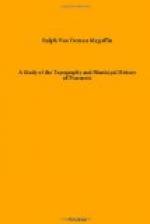BALNEAE, C.I.L., XIV, 3013, 3014 add.
The so-called nymphaeum, the brick building below the Via degli Arconi, mentioned page 41, seems to have been a bath as well as a fountain, because of the architectural fragments found there[133] when it was turned into a mill by the Bonanni brothers. The reservoir mentioned above on page 41 must have belonged also to a bath, and so do the ruins which are out beyond the villa under which the modern cemetery now is. From their orientation they seem to belong to the villa. There were also baths on the hill toward Gallicano, as the ruins show.[134]
BYBLIOTHECAE, C.I.L., XIV, 2916.
These seem to have been two small libraries of public and private law books.[135] They were in the Forum, as the provenience of the inscription shows.
Circus, Cecconi, Storia di Palestrina, p. 75, n. 32.
Cecconi thought there was a circus at the bottom of the depression between Colle S. Martino and the hill of Praeneste. The depression does have a suspiciously rounded appearance below the Franciscan grounds, but a careful examination made by me shows no trace of cutting in the rock to make a half circle for seats, no traces of any use of the slope for seats, and no ruins of any kind.
CULINA, C.I.L., XIV, 3002.
This was a building of some consequence. Two quaestors of the city bought a space of ground 148-1/2 by 16 feet along the wall, and superintended the building of a culina there. The ground was made public, and the whole transaction was done by decree of the senate, that is, it was done before the time of Sulla.
CURIA, C.I.L., XIV, 2924.
The fact that a statue was to be set up (ve)l ante curiam vel in porticibus for(i) would seem to imply that the curia was in the lower Forum. The inscription shows that these two places were undoubtedly the most desirable places that a statue could have. There is a possibility that the curia may be the basilica on the Corso terrace of the city. It has been shown that an open space existed in front of the basilica, and that in it there is at least one basis for a statue. Excavations[136] at the ruins which were once thought to be the curia of ancient Praeneste showed instead of a hemicycle, a straight wall built on remains of a more ancient construction of rectangular blocks of tufa with three layers of pavement 4-1/2 feet below the level of the ground, under which was a tomb of brick construction, and lower still a wall of opus quadratum of tufa, certainly none of the remains belonging to a curia.
[Illustration: Plate IV. The Sacra Via, and its turn round the upper end of the Basilica.]
Forum, C.I.L., XIV, 3015.




